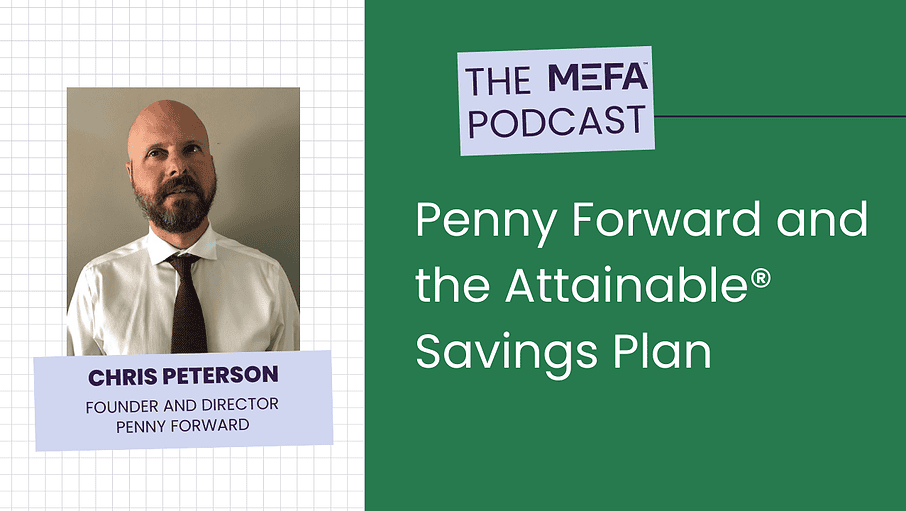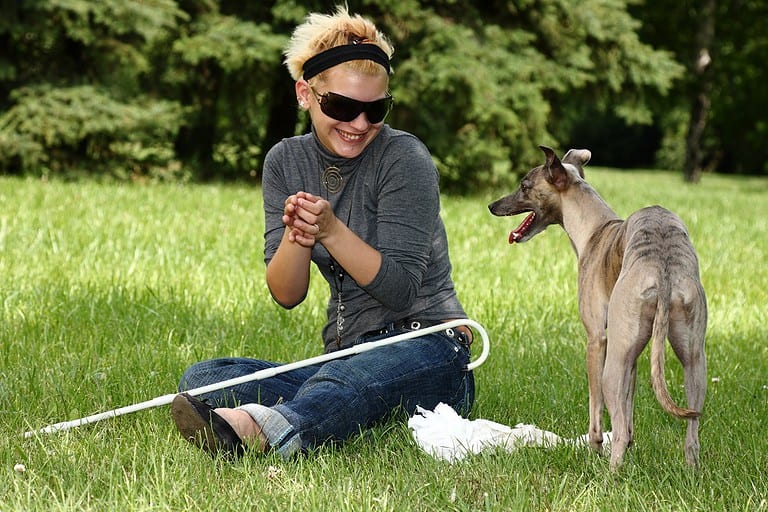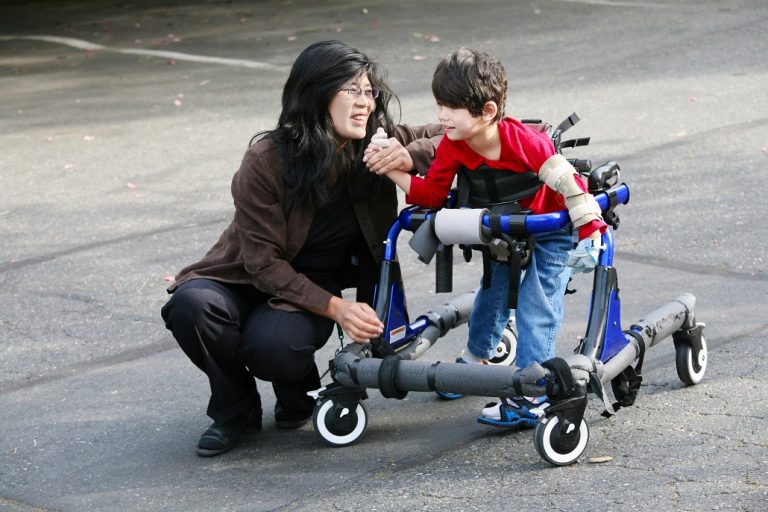

Resources Mentioned in this Episode
Jonathan Hughes: Hello everyone. And welcome to the MEFA podcast. My name is Jonathan Hughes.
Julie Shields-Rutyna: And I’m Julie Shields-Rutyna.
Jonathan Hughes: And we have a great show for you today. This month marks the fifth year anniversary of the creation of the Attainable® Savings Plan. And so we have not one, but two guests on the show to talk about that. Later on in the show, you’ll hear my interview with Chris Peterson.
He’s the Founder and Director of Penny Forward, which he describes as a community of blind people working together to build brighter futures. We’ll talk to him about Penny Forwards financial education services for their members, his own personal story, and his advocacy for ABLE plans among other things.
So you’ll definitely want to stick around for that.
Julie Shields-Rutyna: And of course we have Mary Rubenis, the Outreach Manager for MEFA’s Attainable® program back once again, to talk about how the program was born and how it has changed and grown throughout its first five years. So, Mary, welcome back to the show.
Mary Rubenis: Thank you both, excited to be here.
Jonathan Hughes: So this is a bit of a review from the last time you were on, but I was wondering if you could take us through what the ABLE program is, how it was created, because I like that story, and what do ABLE plans do?
Mary Rubenis: Sure. So I guess I’ll start at the beginning, which was the ABLE act, which was passed federally in 2014 and it established these ABLE accounts, which actually stand for achieving a better life experience. That’s what the acronym stands for. And so it added this section 529a, which is an ABLE account to the tax code, and establish these tax exempt accounts. And it’s for a individual with a disability qualifies to use it for a qualified disability expense.
And we can talk about, you know, what those might look like, what some of those expenses might be. And I always kind of liked to share that the legislation took almost a decade to get passed. And it started with a group of Northern Virginia parents who had a child with down syndrome and they all kind of got together and then lobbied with some national organizations, National Down Syndrome, Congress, et cetera, and got this legislation passed.
So, huge deal for it to come about almost 10 years.
Julie Shields-Rutyna: Can you tell us a little bit about some of the features of Attainable® and then also how folks can get more information?
Mary Rubenis: The disability has to have occurred prior to the age of 26. And then if you’re getting, say SSI or SSD, you’re automatically eligible. But even if you’re not getting those benefits, but you meet that age requirement and then have some type of disability that meets the requirements, then you can open one of these. And so some of the features are qualified expenses for these accounts are things like healthcare, you can use it for housing, pay your rent, pay your mortgage, you can use it for transportation. So, and that even includes Uber and Lyft rides. You can use it for educational expenses. Like you can, you know, a regular 529, assistive technology. Those are some of the things that you can use it for. Some features for Attainable® that I like to highlight. We talk a lot about, you know, people ask the question, how should I keep track of how I spend these accounts? And Fidelity, who’s our program manager. So Fidelity manages our program. And so if you’re going to open one of these accounts, you do it through Fidelity and they manage the assets. They have some great free digital tools. And so I always tell people to look for those. They help you to track and categorize the expenses and keep track.
And one of those is called Full View. So I’ll just mention it here and it allows you to kind of keep track of how you’re spending the account. And sort of manage that aspect for you.
Jonathan Hughes: That’s great. Since you mentioned Fidelity, I was wondering if you could tell me, and you mentioned you did a great job talking about the eligible expenses and the tools that people can use. But how do people actually use the money that they’ve saved?
Mary Rubenis: How it work for our program is the money is in the ABLE account or Attainable®. Then when you want to pay that expense, you actually transfer the funds electronically, either to your personal checking account, or Fidelity also offers a free checking account called a cash management account, and you could transfer it to that.
So you transfer the funds electronically to whatever account you choose. And then you pay the funds, you pay your expenses that way.
Julie Shields-Rutyna: So Mary, I’m thinking how this is the first and only program that MEFA administers that is not solely for education. So, because this is a new area of focus for MEFA, I know we had a lot to learn and new connections to make in the disability community.
And you have been involved in this ever since you started at MEFA. So how did you come to know people for whom this program was meant to help? And what did you learn in that process?
Mary Rubenis: Gosh, that’s a big question, right? Yeah, so I think from the beginning, part of our mission at MEFA was always to, you know, build relationships with the disability community.
And so we got together and had a round table and, and brought some of those organizations to MEFA to talk about, you know, how can we best, you know, share this information with. You know, individuals who have a disability. And so we’ve worked kind of slowly and methodically, I guess, to build those relationships and do events with them.
You know, people like Mass Down Syndrome, Congress, The ARC, we’ve done a lot of work with them, the Federation of Children with Special Needs. So we definitely have thought about, and always felt the importance of building relationships, so that we understood what the disability community needed. And how could we best, I guess, work with those organizations to spread awareness about ABLE accounts.
A big one honestly has been MOD, or the Mass Office on Disability. Most recently, we’ve worked closely with them to work on our accessibility as an organization in terms of mefa.org and all the content we put on mefa.org, but also our presentations, right?
Our presentations, where we’re sharing PowerPoints, we wanted to make sure that all that information was accessible to a screen reader if somebody used a screen reader. So we worked really closely with an individual there to help us to kind of manage all that check off all the boxes, so to speak, in terms of how our site, you know, would work with a screen reader, you know, color, contrast, and fonts, that type of thing.
But, you know, just to just examine all of that. So that was really a big one for us working with MOD, they’ve always been really, just an amazing partner and really helpful to us to work on that. So that’s one, I guess it would speak to, but certainly all those other orgs I mentioned, you know, the ARC and there’s so many really to mention, but MOD is the one that comes to mind most recently around accessibility. We really wanted to, you know, tic away at that.
Julie Shields-Rutyna: And can you talk a little bit about trust and why trust is important in these discussions you’ve had with organizations or families?
Mary Rubenis: Yeah, I think the big challenge for ABLE is awareness and getting people to understand that these accounts exist, but it is also trust because they’ve been told for many years, if they do get benefits that they can’t save and, and they can’t save over the there’s a $2,000 asset cap that currently exists if you get these federal benefits.
So kind of building that trust with these organizations and the populations that they serve is really important so that we can share the information and inform them that no, there is something that exists now that’s going to help you to save. And this is the tool that can do that.
So that’s always been, you know, really important to us to build relationships and build that trust with the organizations, but also with the people that they serve. since that is an issue, you know, people have been told for so many years, they can’t save and now there’s a program out there that allows them to save.
Jonathan Hughes: Can you talk a little bit more about those limits and what people are used to saving and what they can save in their ABLE plans now that doesn’t affect their benefits?
Mary Rubenis: Yeah. So currently, if you do get those federal benefits like SSI or Medicaid, there exists an asset cap where you can’t save over $2,000 or else it will reduce those benefits and impact them.
So if you have an ABLE account or a special needs trust, It allows you to save over that $2,000 asset cap and not impact those benefits up to a certain point. With SSI, you can save up to a hundred thousand dollars for instance and not have it impact your SSI benefits. I guess I’ll just touch on annual contribution amounts now for ABLE have gone up a little bit.
And so you can actually contribute up to $16,000 in a year into your ABLE account now. And then if the account owner is working, you can actually contribute above that amount. If the account owner or beneficiary is working, there’s an added amount that they can contribute into their ABLE account from their work income.
Jonathan Hughes: That is a change that has occurred throughout the year since ABLE was sort of signed into existence that the limits have gone up. With the understanding that MEFA is not advocating for any changes, if there are to be further changes in the future to the ABLE programs, what have been some of the most discussed possibilities?
Mary Rubenis: Yeah, I think the biggest one that comes to mind is they want to raise the age, and that would involve legislation to get passed. And so, there’s a pending bill that they’re trying to push, that the ABLE Age Adjustment Act to get that age raised from qualifying from 26 to 46. So that’s something that’s on the horizon that may happen at some point in the future.
But that ABLE Age Adjustment Act is something that people are definitely hoping will happen, because it would allow, you know, more individuals who currently don’t qualify to qualify for an ABLE account.
Jonathan Hughes: And that is, the disability would have to have been diagnosed before the age of 26?
Mary Rubenis: Yeah. I actually used the word onset
Jonathan Hughes: Onset. OK.
Mary Rubenis: Yeah. Because sometimes with like even mental health disabilities, you may have not got diagnosed until later in life. But as long as you can prove that the onset of the disability occurred prior to say the age of 26, which is the current, then you’re eligible.
So yeah, they’re looking to raise it in terms of ABLE Age Adjustment to raise it to 46. So yeah, I use that word onset as long as you can, you know, prove that the onset of the disability occurred, then you’re eligible.
Julie Shields-Rutyna: This is such great information. And so thank you, Mary and happy birthday Attainable®.
Mary Rubenis: Happy birthday Attainable®. Thank you both. Thanks for having me.
Jonathan Hughes: Do you want to stick around and answer a MEFA mailbag question? I’ll tee up an Attainable® one for you.
Mary Rubenis: Sure.
Jonathan Hughes: OK. So now we’re going to head to the MEFA mailbag, and these are questions that have come into us from customers over the past few weeks and answered by our college guidance experts.
Now, remember if you have any questions, you can please reach out to us at [email protected], or you can call us at 1-800-449-MEFA. Or you can reach us on social media, on Facebook at MEFAMA, on Twitter @MEFAtweets, and on Instagram at MEFA_MA. So I’ll just throw out a question that we get often from folks who have questions about Attainable®. And that is, can you roll over 529 funds to an ABLE account?
Mary Rubenis: Yes, you can. And that’s called the ABLE Financial Planning Act and it allows you to roll over unused money or maybe overfunded 529s. Sometimes I’ve heard financial planners talk about that where a family or a grandparent might have funded a 529, and then realized the child or an individual isn’t going to go to college. Well, now they can roll over up to $16K in a 12 month period. Roll over funds from that 529 into that individual’s ABLE account with no tax or penalty.
Jonathan Hughes: All right. Well, again, thank you Mary. Remember, if you have any questions you can call us up at 1-800-449-MEFA or you can email us at [email protected]. We have a bench of college guidance experts waiting to answer your call. Now let’s go to my interview with Penny Forward’s Chris Peterson.
Jonathan Hughes: In 2020, my guest, Chris Peterson founded Penny Forward, which he described as a community of people who are blind, their families and friends who share an interest in financial independence.
Penny Forward’s mission is to help people build the knowledge to confidently navigate the complicated landscape of personal finance through education, mentoring, and mutual support. He came to our attention through his advocacy on behalf of the ABLE program. And we will talk about the ABLE plan among other things. But first I want to welcome you to the show. Chris Peterson, thank you for being on the MEFA podcast. Nice to meet you.
Chris Peterson: Nice to meet you. Thanks for having me.
Jonathan Hughes: Of course, my pleasure. Now I was sort of going through and preparing for the show and, and reading up on your website and I got to your bio and the first line of your bio is very striking. And I wonder if I could read from it.
So it reads Chris Peterson was born blind and raised with the expectation that he would lead a successful life. So can you tell me what was meant by that and how was that communicated to you?
Chris Peterson: It was kind of communicated to me that when my parents looked at other blind kids or blind adults that they happen to meet, a lot of them weren’t necessarily involved in much. Kids in particular sometimes were overprotected, maybe sheltered a little bit. And adults were, you know, a little bit isolated, and maybe not employed or not particularly well off financially. And their expectation was always that I was going to live at least the kind of life that they were living, which is a pretty standard middle class life.
And that I should expect that I’ll probably go to college, start a career, and raise a family, and do all of the kind of normal things that make up the American dream.
Jonathan Hughes: Was college a part of that? Was that something that was understood, that you would go to college?
Chris Peterson: It was understood, but my parents didn’t save for me at the time. There, and I think this might still be true but it’s not necessarily available to everybody, the state of Minnesota University system offered free tuition to blind students and Minnesota State Services for the blind would cover, you know, basically your full ride if you went to a state school or a school that was similar in costs to the University of Minnesota.
So that’s what I ended up doing is going to a small state school and getting my college funded through the blind rehabilitation system.
Jonathan Hughes: Where did the interest in computer science come from?
Chris Peterson: I was always interested in computer science, particularly computer programming. Growing up, I liked to build things.
I was kind of into woodworking when I was younger, and I never felt like I was particularly good at that. I wasn’t sure how to make every part of woodworking accessible. But I learned that it was really easy to build really neat stuff by writing a computer program. So I taught myself programming pretty much starting from age six. You know, growing up, I fooled around with that kind of thing all through junior high and high school. And it seemed natural when I did decide to go to college to get a computer science degree because I loved programming so much.
Jonathan Hughes: So what college did you attend?
Chris Peterson: I attended a small state school called Southwest Minnesota State University. And the school is interesting in that it was built with accessibility, particularly physical accessibility for like people who use wheelchairs, in mind in the late 60s.
And it’s a little town called Marshall, Minnesota. And I had a really, really wonderful experience there. It’s still something that I look back on quite fondly. The college itself was physically very accessible and the faculty was happy to have me there, which isn’t always the case, and was very encouraging of me and, you know, really worked hard to make sure that I succeeded. Which also isn’t always the case. So my experience was really, really good.
I would say from talking to other blind people though, that that is more rare than it is common. It’s, you know, there’s a lot of barriers to success in college that take many forms.
Jonathan Hughes: What are some of the things that you hear?
Chris Peterson: Well, I mentioned that the faculty was pleased to have me there and was encouraging of my success. One of the first things that I hear from people is that they have trouble with their professors not wanting to teach a blind student. It feels like extra work to them and they don’t know how a blind student is going to do the work.
And they aren’t interested in changing the way that they work to accommodate a blind student. And so, you know, it’s hard to be successful in an environment like that. And it’s also very, very hard on your mental health. If you kinda know that you’re struggling to learn something new and also struggling just to be accepted where you were.
I graduated in three years, but what I sacrificed by doing that was looking for and getting involved in internships and work opportunities during college. So when I got out of college, my job search was a little bit hard. And, uh, you know, I can blame some of that maybe on disability discrimination and just some of that on my own lack of planning because I hadn’t done any internships or made any connections while I was in school.
So it took me around nine months after I graduated to find a job. It didn’t help that the girl that I followed to college ended up taking a job in another kind of small town called Rochester, Minnesota.
And I followed her there. And there were really two large employers in Rochester. One of them is a medical, the Mayo Clinic, you know, famous medical institution. And the other one is, was IBM. So, you know, I pretty much banged on IBM’s door for nine months until they let me in.
Jonathan Hughes: So you have been working at IBM ever since?
Chris Peterson: I worked at IBM up through 2014. The part of IBM that I worked for at the time was sold to a company called Lenovo. And I worked for Lenovo for another five years after that. And in 2019, I left Lenovo and got a job with a local company here, a financial services company called Thrivent Financial.
I had been interested in personal finance a little bit over the last few years. I had been talking with my financial advisor. He had told me he thought I might make a good financial advisor. And so I had asked him to help me make some connections, to see if I could make that a reality and Thriving Financial was where he worked. And I had actually started interviewing there for a financial advisor position.
And then my wife came to me and told me that we were going to have another baby, which was a surprise. And it didn’t seem like making a career change to become a financial advisor while trying to raise an infant was the best choice in the world, but I was trying to figure out how to gracefully back out of the interviews. And a recruiter reached out to me through LinkedIn and said our client Thrivent Financial is looking for a lead software developer in Minneapolis. Would you be interested? And I immediately responded that as a matter of fact, I was already interviewing with Thrivent Financial, and I would be very interested. So I thought, you know, I had thought maybe I’d work at Thrivent as a software developer for a few years and then try financial advising again.
And I thought maybe I could build a market for myself for that, by doing a blog or a podcast or something. And as I started to think about it more, and as I started to talk to people, I learned that there’s kind of a mistrust of the financial services industry among a lot of low-income populations.
And there’s a large percentage of the blind community that is lower income. And I was trying to figure out from talking to them how to do something that would be trustworthy. And one of the things that people said was, well, you know, we’d really rather work with a nonprofit organization. That’s not whose goal isn’t to make money off of us.
So ended up starting the Penny Forward blog and then came the Penny Forward podcast and it started to take off. And I started to get to know people who thought that my vision of starting a nonprofit organization to teach blind people personal finance was a pretty neat idea. And was able to pull together five people who wanted to sit on a board of directors and help me found this thing.
Jonathan Hughes: Tell us about Penny Forward then and how can people interact with this organization right now?
Chris Peterson: People can interact with the organization by looking at the website and listening to the podcast. The podcast is, I say it’s about blind people building bright futures, one penny at a time. One of the questions that we have from blind people who are unemployed or under employed is how can I think about managing my money well, or saving money or building credit if I don’t have a job.
And so we bring people on who have jobs and we talk to them about how they got their job, what they’ve learned from the process, what advice they might give to other blind people. And occasionally we have experts on that talk about finance related topics, things that people may not know anything about because they have no experience doing these things.
For example, ABLE accounts is something that a lot of people are aware of by name. But don’t know how they operate or what they’re for. And so early on, we were able to bring on Miranda Kennedy from the ABLE National Resource Center, and talk about ABLE accounts.
And so our goal really is to deliver content that helps people to figure out how they’re going to make money. And once they have it, how to manage it well. And we hope that they also want to grow, so that they can be positioned well to take advantage of rare opportunities, weather hard times, and generously support causes that they care about.
Jonathan Hughes: And just so folks know, an ABLE program is a tax advantage account that was created for individuals with disabilities. And these individuals can save funds and have them grow with no taxes and use the funds tax-free to pay for a wide variety of expenses. And so, you know, I noticed on the Penny Forward site, you link to ABLE resources, which is great. How was the awareness or the popularity of ABLE plans changed things for you and for the community?
Chris Peterson: Well, first of all, I wasn’t aware of ABLE plans until I started Penny Forward and realized that I needed to really bone up on what was out there for people with disabilities. And so when I ran across ABLE accounts, I immediately, because I’ve been saving and investing for quite a while now, I recognize the potential of them.
Like I said before, I’ve noticed from talking to people that many people are aware that ABLE accounts exist, but not necessarily aware of how they operate or how they can get an ABLE account or maybe why they might want one. And because of those things, the uptake of ABLE accounts, particularly in the blind community, according to the ABLE National Resource Center has been very low. And we don’t know exactly why that is, but we think that one of the reasons may be that blind people are having trouble getting access to information that can teach them what an ABLE account is, how you would use it once you have it, and why it would be helpful for you. So that was one of the first things that I wrote about when I started Penny Forward. It was a five-part series breaking down ABLE accounts into really simplistic terms and saying, here’s what this, here’s how it might help you, and here’s where you go to learn more.
And that in combination with the podcast episode on ABLE accounts, has really generated a lot of interest. There’s maybe people that want ABLE accounts and still feel shut out of them. Even though I think most states and the ABLE account managers themselves have done a really nice job of making the application simple and accessible online. But there are some people that online isn’t working for.
Jonathan Hughes: And are there other barriers that folks have experienced in order to be eligible, to participate in enable account?
Chris Peterson: You need to have become disabled before age 26. So that is a barrier to people who have lost their vision a little bit later in life, which is fairly common.
Another thing that people often cite as a reason that they don’t want to participate in an ABLE account is the part of the law that says the state may come back and basically take any assets that are in your ABLE account to cover the costs of any public benefits you received after you die. And people are concerned about that because they want to, if they’re saving and investing, they want to be able to provide for their families.
Jonathan Hughes: How would you encourage others to open ABLE accounts?
Chris Peterson: First of all, I would say that if you’re tech savvy, the application process for an ABLE account is really simple and easy to navigate, and doesn’t really cost you anything to go through.
So from that perspective, there isn’t a lot of risk in giving it a try. The second thing I would say is that invest in a portion of your money and it doesn’t matter how small the amount is. Investing your money over a long period of time is going to give you a cushion. That cushion might be enough to help you pay an emergency bill.
Or it might be to help you cover the moving costs if you’re offered a job outside of your local area and you’re not sure how you’re going to take it. This has actually happened to a couple of people I know. And for parents of children with disabilities, an ABLE account can be a really great savings vehicle for them.
If you find out that your child is blind when they are an infant, you can, it can be very understandable for you to wonder whether your child is going to go to college or not. Because some forms of blindness can come with other, other types of disabilities that you’re not necessarily aware of at infancy and let’s face it, there’s just, most parents that have a blind child have never thought that they were going to have a blind child. They don’t know very much about blindness and so they may not really be aware of what other blind people are doing. If you’re concerned about your kid not being able to go to college at some point, you still want to save for them, for whatever future they might have.
Putting $25 to $50 a month in an ABLE account can really, really pay off by the time they turn 18 or 19 years old. I’ve put together a chart on pennyforward.com that describes this.
Jonathan Hughes: One of the other aspects before we go off the ABLE plan, which I think is really beneficial, and that is the asset limit on that. And how that affects means tested benefits. I’m wondering if you could talk about that a little bit. You know, if that played a role in your decision to open an ABLE plan?
Chris Peterson: Yeah. Well, let’s remind people, first of all, what means tested benefits are in case they don’t know? We’re talking about things like social security benefits that are available to people with disabilities who haven’t worked before, called SSI or supplemental security income, things like Medicaid, which are critical for people with complex medical conditions. Een stuff like snap food stamps benefits can be means tested. And what means tested means is that you have to not be making very much money in order to qualify for them, but you’re also not allowed to keep a lot of the extra money that you might have as a result of collecting those benefits. In other words, you really can’t own much or you no longer qualify for the benefit.
And if a person with disability we’re to be given a hundred thousand dollars by friends and family, for example, they would no longer be qualified for these means tested benefits. And you might argue that, well, gosh, if somebody has a hundred thousand dollars, they don’t need a paycheck from social security. But they very well may need medical care to cover a complex medical issue that might be more costly. It might blow away that whole hundred thousand dollars all in a few office visits.
So for those people being able to continue to rely on those programs is really critical. And what an ABLE account does, because this is what the law says that it’s supposed to do, is it allows you to save, or to receive money from family and friends and save that money and an ABLE account without it impacting your eligibility for benefits. And I specifically mentioned a hundred thousand dollars because the law says that you are able to save up to a hundred thousand dollars and still be able to receive means tested benefits.
Once you get past that, they still will start asking you to spend down until you get back below a hundred thousand dollars. An ABLE account is not something that’s meant to be saved forever. But it definitely is way better than the $2,000 limit that people used to have without ABLE accounts to be able to receive these benefits.
Jonathan Hughes: Have you experienced people not quite believing that?
Chris Peterson: Yes. Yes. I’ve experienced people not quite believing that that’s true. I’ve also experienced people not really understanding how money is going to get in the account. Especially if they’re low income, you know, that they’re having trouble making ends meet.
A lot of people have trouble envisioning how they would put away any money at all. And even if they could put away a small amount of money, they have trouble believing that it would be. And that’s why I talked about, you know, even $25 or $50 a month can over the course of 18 or 20 years, you know, you really can grow that. It’s entirely possible.
And so I, frankly, know exactly how to help people to trust that ABLE accounts are real legit things. Other than to say that I have one and I put money in it and it’s working for me.
Jonathan Hughes: And the website is pennyforward.org.
Chris Peterson: It is pennyforward.org or .com. Either one, if you forget, one or the other one.
Jonathan Hughes: Well, good luck with that. Thank you so much for being here. I had a great time speaking with you and hopefully we can do this again.
Chris Peterson: Yeah. Thanks for having me.
Jonathan Hughes: All right. Well that about wraps it up for us today. Once again, thanks to Chris Peterson for sharing his time and his expertise with all of us today. Mary, thank you for joining us. Pleasure as always. And folks, if you liked the show today, and you want to hear more from MEFA on all topics related to planning, saving for college and career readiness, and reaching financial goals, please subscribe to us on Apple podcast, Sticher, iHeartRadio or wherever you get your shows from. And whether you’re a new or regular listener, please remember to rate and review us so we can keep doing what we’re doing and getting good information out to people like you, Julie. Thank you.
Julie Shields-Rutyna: Thank you, John. It seems so oddly formal, that was thank you to there at the end of every episode, but I haven’t thought of anything better yet.
Jonathan Hughes: Thank you to our producer, Sean Connolly and our editor Lauren Patten. Once again, my name is Jonathan Hughes and this has been the MEFA podcast.













